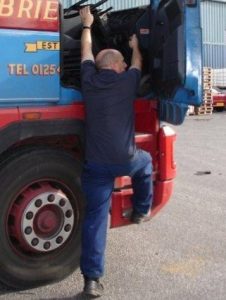

Of definable driving groups,prevalence rates of lower back pain have been found to include 81% of bus drivers1, 60% of truck drivers2 and 51% of taxi drivers3.
It has been suggested that professional drivers are at an increased risk for low back pain and injury due to a range of reasons including whole body vibration, shocks and jolts, prolonged sitting, and postural factors.4
The European Committee for Standardization reported that long-term occupational exposures to whole-body vibration (WBV) from machines and vehicles used in industry, agriculture/forestry, and public utilities are associated with an increased risk of low back pain (LBP), herniated disc, and early degeneration of the spine in the exposed drivers.5
Whole body vibration is shaking of the body that occurs when in contact with a surface that is oscillating eg car wheels over an uneven road surface or the vibrations from the vehicle engine. The vibrations from the car are transferred through the body to the spine and soft tissues which in turn can cause damage and back pain.
Shocks and jolts injure the lower back by exposing it to sudden forces. They typically occur when hitting a bump or pothole, or during a vehicle collision. Exiting from high vehicles using incorrect techniques such as jumping also brings about a similar effect.
Many drivers sit in awkward postures for long periods. Whilst in the sitting position, the spine is under greater pressures in certain areas. Postures such as slumping and slouching can further increase the stress and tension in the lumbar spine and surrounding muscles and ligaments causing discomfort and pain.
References
- Magnusson ML, Pope MH, Wilder DG, Areskoug B. Are occupationaldrivers at an increased risk for developing musculoskeletal spine disorders? 1996; 21: 710-17.
- Robb MJ, Mansfield NJ. Self-reported musculoskeletal problems amongst professional truck drivers. Ergonomics 2007; 50: 814-27
- Chen J-C, Chang W-R, Chang W, Christiani D. Occupational factors associated with low back pain in urban taxi drivers. Occup Med 2005; 55:535-40.
- Lyons J. Factors contributing to low back pain among professional drivers:a review of current literature and possible ergonomic controls. Work 2002; 19: 95-1
- Comite´ Europe´en de Normalisation 1996
